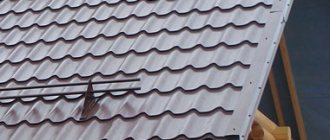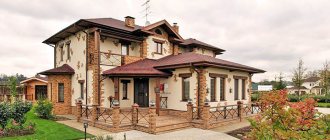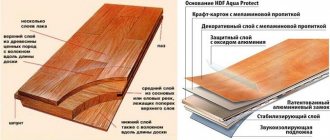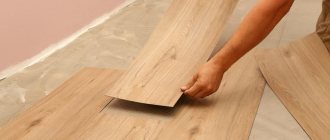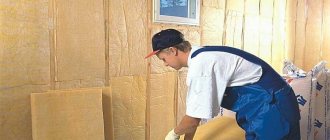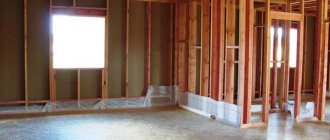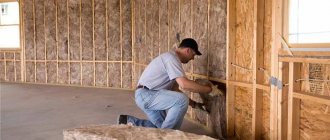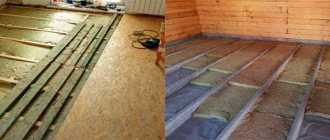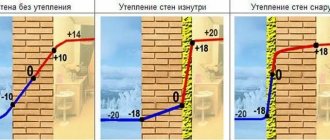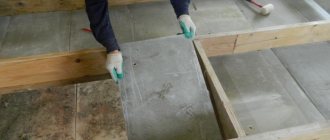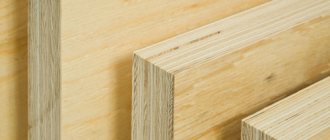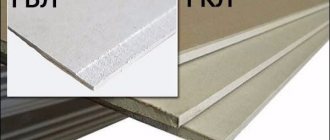The use of wood as the main material for construction is a classic tradition. Houses made of wood are often found in rural areas. The main point in the construction and cladding of buildings is the need for proper thermal insulation.
In addition to reducing the cost of heating the building in winter, this allows you to spend less on powering cooling systems in the summer. Which insulation to choose for finishing the walls of a frame house?
Insulation pie
Basalt wool - what you need to know?
Insulation based on basalt wool is characterized by glass fiber, combined with special components to maintain the bond and improve the hydrophobicity of the material.
An important advantage of thermal insulation based on basalt wool is its resistance to high temperatures, which is especially noticeable when compared with mineral wool insulation. In addition, the insulator is characterized by:
- lack of ability to release toxins when the temperature rises;
- resistance to dirt and fungi;
- high melting point;
- simple transportation and installation.
The manufacturer of thermal insulation made from basalt wool claims a fifty-year service life, subject to the basic rules of use. In addition, the characteristics of the material indicate a high level of sound absorption, which allows it to be used for insulation and noise reduction in rooms for various purposes.
Insulation made from basalt wool is much better than mineral wool in terms of vibration resistance, does not belong to the group of explosives, and is suitable for insulating environments with elevated temperatures and aggressive types.
Analyzing how insulation based on basalt wool is really better than mineral wool, it is worth noting the special chemical composition of the material. It does not include dolomite and limestone elements, which are necessarily included in the glue required for installing mineral wool.
Basalt insulation, despite all its positive qualities, weighs little and exhibits increased resistance to mechanical damage
This is important because in the stage of destruction, insulation materials pose a real danger to human health who inhale microparticles of fibers floating in the air
The material also has some disadvantages. Stone wool is sold at a fairly high price, different from the cost of mineral wool - rather a budget option.
The peculiarities of the insulation structure can also be considered a disadvantage. The material in the form of a slab, most often used for thermal insulation, has many seams at the joints, which can cause poor quality thermal insulation, especially if errors are made during installation.
In terms of safety, insulation based on basalt wool is considered more environmentally friendly than conventional mineral wool, despite the minor inclusions of phenolic binders in the composition.
So, summing up the differences between basalt thermal insulation and other types of mineral wool-based insulators, it is worth noting the following important factors:
- the material is resistant to chemical and biological attacks, which distinguishes it from the same glass wool;
- the plasticity of the material exceeds the same parameter of mineral insulation materials, including glass wool;
- the material provides a high level of thermal insulation, significantly higher than that of glass wool analogues.
How much the advantages outweigh the above disadvantages is something everyone decides for themselves after analyzing the features of alternative types of insulation, including those based on mineral wool.
Video description
We will dwell in more detail on insulating a house with polystyrene foam. Find out how safe polystyrene foam is in our video:
Expanded polystyrene (penoplex)
Expanded polystyrene is a popular thermal insulation material due to its long service life, low cost and excellent sound and heat-saving properties. The material demonstrates high hydrophobicity (absorption volume is no more than 3% of weight), compressive and bending strength, fire resistance and non-toxicity.
train schedule romanovskie dachas lublino
Penoplex boards are attached to the frame posts with glue. Experts advise protecting the material from solar ultraviolet radiation.
Expanded clay
The material is the most common and proven fill-type insulation; It is used in thermal insulation of floors, floors and walls. Expanded clay is based on refractory clays, which are subjected to heat treatment during the production process. The result is granules, crushed stone or sand with a characteristic porous structure and attractive parameters, which include good thermal insulation and low weight, environmental friendliness, chemical inertness and vapor permeability.
Expanded clay is not flammable and does not lose its thermal insulation properties when temperature fluctuates. The only drawback of expanded clay is that its heat-protective properties are inferior to synthetic materials.
Foam glass
Not only expanded clay is produced in the form of granules, but also foam glass - a material with a higher level of thermal protection. Sand and broken glass are used to make it, which automatically turns the material into the safest and cleanest product. Granulated foam glass is indifferent to bio- and chemical agents, moisture-resistant, and its only (and tangible) disadvantage can be considered its high cost.
What properties should insulation for a frame house have?
Insulation materials used to insulate the walls of a frame house must have the following properties:
- low thermal conductivity;
- fire safety;
- low water absorption;
- no shrinkage;
- environmental friendliness.
Thermal conductivity
The ability of a material to transfer heat is reflected by its thermal conductivity coefficient. The lower its value, the less heat passes through the material. At the same time, in winter the room does not cool down so quickly, and in summer it heats up more slowly. This allows for savings on cooling and heating. For this reason, when choosing insulation, be sure to take into account the value of the thermal conductivity coefficient of the material when operating under specific conditions.
Water absorption
The next important indicator affecting the ability of insulation to retain heat is its water absorption. It represents the ratio of the amount of water absorbed by the insulation to the mass of the insulation itself. This characteristic demonstrates the ability, in the case of direct contact with water, to absorb and retain moisture in the pores.
Due to the fact that wet material conducts heat well, the lower this value is, the better. This is explained by the fact that when wet, the air pores of the insulation are filled with water, which has greater thermal conductivity than air. In addition, material that is too wet can simply freeze, turning into ice and completely lose its functions.
Fire safety
Fire safety of materials means the ability to withstand high temperatures without damaging the structure or igniting. This parameter is regulated by GOST 30244, GOST 30402 and SNiP 21-01-97, which divide them into flammability groups from G1 to G4, while completely non-flammable substances are designated NG. For frame residential buildings, insulation materials belonging to the NG group are most preferred.
Insulation shrinkage
When choosing a heat insulator for a frame building, you should definitely take into account such an indicator as shrinkage ability. This value must be minimal, otherwise during operation, material subsidence will appear in the places where the insulation is laid, which will lead to the formation of cold bridges and an increase in heat loss.
Environmental friendliness
The basis of the walls of a frame house is insulation. Since insulating material will surround you everywhere in a frame house, you need to be sure that it is really high-quality insulation and does not emit harmful substances.
Lyrical digression or a little background
The cottage that you, dear viewers, see behind me, was built exactly twelve months ago. The object has a frame base. It is assembled from larch. Inside there is a planken imitation of timber. The object is insulated with cotton wool with a thickness of 150 millimeters. After about eight months, the ecowool sank by fifty percent, which for the owner, naturally, resulted in a sharp decrease in the temperature in the living quarters.
When the improperly blown cellulose settled, the cottage understandably began to freeze. This, of course, alarmed the owner. He turned to us for help. I called the phone number on the website and called to the site to receive free consulting support. We arrived, carried out an inspection with a thermal imaging device, oh, where there is a priori no ecowool, identified freezing angles, and so on...
The most suitable places for insulation
To summarize the above, it is worth highlighting the compatibility of materials with various surfaces or areas of private houses.
Foam is suitable for:
- horizontal and vertical parts of foundations (good contact with wet ground);
- external or internal walls of houses, regardless of material;
- unventilated roofs (flat, insulated);
- attic floors/floors of the upper floors.
Mineral wool is suitable for:
- wooden (“breathing”) houses (outside - only with a ventilated façade);
- attics, mansards, pitched roofs;
- brick houses;
- concrete or reinforced concrete buildings (for example, garages);
- places that periodically become very hot;
- frame structures of any type;
- pipes of water, gas and other mains.
The prevalence of expanded polystyrene with mineral wool is due to the good characteristics of insulation. Of course, the materials have not only advantages, but it is from this pair that you should choose a long-lasting home heat keeper.
Thermal insulation with mineral wool: step-by-step instructions
In most cases, mineral wool in the form of mats . Therefore, subsequent instructions will be based on working with this material.
Preparatory activities
The first thing you need to do is understand the structure of the insulation cake, calculate the material and prepare the surface for installation. It doesn’t matter which side to start the work from - outside or inside. Some people believe that it is more convenient to perform thermal insulation from the street side. However, weather factors must be taken into account.
The standard structure of a thermal insulation cake with the order of layers from the internal cladding to the facade of the house:
The recommended pitch of frame beams is 580-590 mm. This range is optimal when using standard mineral wool mats 60 cm wide. According to the standards, the thickness of the insulation for temperate climates is 150 mm. To fill the space between the beams of 15 cm, it is advisable to use mineral wool of two sizes: 50 and 100 mm.
Surface preparation comes down to cleaning off dust, removing protruding nails and blowing in the cracks with foam between the frame elements. Before attaching the insulation, it is necessary to check the wooden structures for dampness, and dry the problem areas with a hair dryer.
Interior finishing: sequence of layers
First you need to prepare the base for laying the insulation. On the inside of the house, this role will be performed by a vapor barrier film and OSB boards .
In the future, OSB boards will serve as the basis for applying the final finishing to the walls.
Rules for installing insulation
An important advantage of using mineral wool or wood fiber insulation is the ease of installation with your own hands. Both heat insulators are quite elastic, so they do not require additional fixation. The slabs are inserted between the frame posts and are held in place due to the slight difference in size.
To ensure that the thermal insulation layer does not lose its effectiveness over time, it is necessary to follow certain rules for its installation:
The film insulation is fixed with a stapler. For more reliable fastening, you can use a counter-latching system.
External wall cladding
The beams attached on top of the wind barrier create the necessary air gap between the thermal insulation material and the exterior finish. Further insulation of the facade depends on the material of the finishing cladding.
Under the block house and siding of various types, moisture-resistant OSB boards are nailed onto the sheathing, to which guide bars are attached. Artificial, natural stone or facade tiles are laid directly on oriented strand boards.
Thermal insulation of a house roof
High-quality roof insulation is of great importance in preserving heat. Thoughtful and well-executed thermal insulation of the roof of a frame house saves 25-30% of thermal energy. A popular insulation option is placing mineral wool between the rafters. The roofing pie must be supplemented with a vapor barrier film and a diffusion membrane.
install a lightning rod in a private house
We will describe sequentially how to properly insulate a roof :
Insulation of the first floor floor
A lot of heat also escapes through the foundation of the house - about 15-20% of heat costs fall on the floor. As an option, you can organize water underfloor heating. However, it is easier and cheaper to insulate the base with mineral wool.
The described technology is suitable for insulating interfloor or attic floors.
Compare by cost
The cost of glass wool, basalt or stone wool depends on several parameters:
- density;
- type of material (roll, plate);
- brand.
Thus, the average cost of glass wool “Ursa M-11”, located in a roll in two layers, with a length of 900 cm and a width of 120 cm, is 1170 rubles. The price of a package consisting of 12 slabs (50*600*800 mm) of Rockwool stone wool is 495 rubles. Pack of 5 slabs measuring 150*600*1200 mm of Rockwool wool – 930 rub. Stone wool from other manufacturers has different prices, which often depend on the promotion of the brand. Products from the most popular brands are always more expensive.
Ecowool is sold in bags or polyethylene packages of rectangular cross-section. The price for this material is indicated differently: per 1 kg or per 1 m³. The average price for 1 kg is 33 rubles, for 1 m³ – 1400 rubles. The spraying method of this insulation makes it possible to obtain different densities of the thermal insulation layer, the final cost of which is calculated taking this parameter into account.
A variety of methods for using ecowool
The second most popular material for thermal insulation of frame buildings is ecowool. But here it is better not to experiment and entrust the work to professionals. Mechanized backfilling will ensure the required density and uniformity of laying. There are three methods of using ecowool:
The dry method is applicable for horizontal surfaces, inclined closed cavities, filling interfloor ceilings and non-demountable structures. The packing density of ecowool using this method is 45-65 kg/cubic meter. m depending on the slope.
Wet technology is suitable for vertical open walls. Ecowool flakes are moistened and applied to the surface under pressure. The density of the thermal insulation layer is about 65 kg/cu.m. m.
The adhesive method is similar to the previous one, but instead of water, an adhesive component is added. Advantages of the technique: high adhesion of the insulation to the wall, elasticity of the material and low deformation after drying. The adhesive method is indispensable for thermal insulation of flows from below; this option is also suitable for treating walls.
The issue of insulating a house needs to be thought through at the construction stage. This is more profitable from a financial point of view and technically correct. Structural elements are insulated as the building is erected, and there is no need to carry out major repairs to the building after commissioning.
Factors influencing choice
It is not always easy to choose between stone wool and mineral wool. The differences lie not only in the production and natural characteristics of the product. There are other, no less important parameters:
- Price. Basalt products are more expensive, even with identical product characteristics.
- Fastening methods. When choosing a material, you should consider what fastening method will be used. Mineral wool is better suited for indoor use, while stone wool is better suited for outdoor use.
- Hygroscopic indicators. Basalt wool is ideal for rooms with high humidity. If humidity levels are very high, additional insulation may be required.
Mineral wool will be more practical due to the fact that it does not ignite.
But some disadvantages of the materials should also be taken into account. Over time, the glass and quartz that make up glass wool begin to crystallize. This leads to large product shrinkage. Product service life does not exceed 25 years.
A basalt product can last more than 50 years if the operating rules are followed. In addition, this type of raw material can be used on all types of surfaces. The material is ideal for insulating a private home. It can warm you up in cold weather and keep you cool in hot weather.
The technology for making mineral wool involves the use of additional additives that attract rodents. For this reason, it is not relevant to use insulation on the outside of the building. If mice get into the house, the insulating coating will become unusable. Rock wool is not of interest to rodents.
These materials are incredibly similar in their characteristics. The choice should be made based on personal preferences and the availability of funds. If family members have allergies or are building a children's room, it is better to choose stone wool.
https://youtube.com/watch?v=eHT165_JaYA
PS – a few points about thermal imaging inspection
The voice-over belongs to the master. He reports that at this site the team completed the insulation of a frame house with environmentally friendly cellulose. The guys are currently carrying out a thermal imaging inspection to ensure the job was done correctly and if there were any omissions. Pay attention to the display of the automatic device - you will see the result of the work with your own eyes.
The sun is shining outside today, which creates some difficulties. As you can see on the device screen, yellow spots are visible in the window area. They indicate a clear warming of those places where the sun's rays fall. What are we seeing in the area of the main wall? It has leveled out for us, severe heat losses have gone away. The temperature in living quarters is now plus 21 degrees Celsius - comfortable and cozy.
On the walls we observe an average temperature of eighteen degrees on the same Celsius scale. There are relatively small deviations that we have not corrected because they cannot be solved a priori. What are these problems? This is a harness around the building. It will need to be caulked separately, because there is a strong blowing from there. The average temperature difference does not exceed 1.5-2 degrees Celsius.
We used more than a hundred bags of premium ecowool here. The second wall, before blowing, had a lot of shrinkage, which has now gone away for objective reasons. In the corners, if you look closely, the temperature is about fifteen, about fourteen degrees - the differences are insignificant. Well, let's move on to the problem areas that one of the measurers pointed out to us.
Where we proposed installing refrigeration equipment, now the maximum permissible point is ten degrees. Naturally, we corrected this situation. There were no problems on the next wall either. The situation has leveled out. Seventeen exactly! Well, look at the individual corners that we couldn’t do. They show fourteen and fifteen degrees Celsius. In general, that’s all, until we meet again on air.
Don’t forget to subscribe to the YouTube channel “Ekovata-MSK” to keep abreast of company news. Be sure to visit our site on “Yandex Zen”, and also subscribe, if not difficult, to the Instagram account at ekovata-msk. See you later. Take care of yourself and your loved ones!
Features of the species
There are several types of insulation, mainly divided by composition.
Minvata
One of the most common thermal insulation materials on the Russian market is mineral wool. This is mainly due to a combination of price and technological properties of the material itself. It is very easy to use. It is advisable to choose a white, soft and self-adhesive material for the timber.
The name “mineral wool” is inherent in many thermal insulation materials that differ in their composition and properties. Not particularly popular is insulation, which is made by melting certain rocks to form certain fibers. During manufacturing, these fibers are woven into a single carpet; this wool is called “basalt”. Any resident of Russia and the CIS is familiar with the term “glass wool”.
This thermal insulation material is an outdated technology, but due to its price it is still in demand today. It is made by melting broken glass into single fibers. There is also cotton wool obtained by melting waste from the metallurgical industry (slag wool).
Characteristics, pros and cons
Cotton wool differs from each other in technical characteristics. Glass wool has a high temperature threshold of 450 degrees, after which the material becomes irreversibly damaged. The density of glass wool is 130 kg/m3, and the thermal conductivity is about 0.04 W/m*C. This material is not flammable, it does not smolder, and has a high vibration and sound absorption threshold.
The disadvantages include the fact that when water gets in, all the positive properties of this material disappear. Glass wool is a rather brittle and brittle material. Upon contact with skin, it causes irritation and itching, which is difficult to remove.
Basalt wool can withstand high temperatures (up to 710 degrees). Its thermal conductivity is about 0.04 W/m*C, density varies between 210 – 230 kg/m3. Unlike glass wool, this material is not afraid of moisture and does not lose its properties. When contacted with skin, roll insulation does not cause irritation or itching.
Slag wool has the greatest mass and density. Its density ranges from 390 to 410 kg/m3, and its thermal conductivity is about 0.047 W/m*C. However, its temperature maximum is much lower (about 300 degrees). The slag melts, and during the melting process its structure is destroyed, irreversibly.
The sizes of these materials vary, depending on the manufacturer's standards. However, the most common ones are:
- length from 3 to 6 m;
- standard width is 0.6 or 1.2 meters.
Some manufacturers make other width sizes (0.61 m). The thickness of the wool is standard (20, 50, 100 and 150 mm).
Foil material
Often one side of the insulation is covered with a layer of foil material. This allows you to protect the coating from moisture and ultraviolet rays. Most often, such materials are used for internal insulation of premises; the wool itself can be absolutely anything. The types of such material are varied. These include polystyrene foam, cork, and polyethylene.
The most popular material on the market is polystyrene foam. It is very practical and inexpensive. Copes perfectly with sound insulation and vibration. The length of the roll is usually 10 m, the width does not exceed 0.5 m. This material copes well with moisture and fungus. However, in terms of thermal insulation, it is significantly inferior to foamed polyethylene.
Thermal insulation with cork is characterized by high strength, light weight, harmlessness and good appearance. For wet rooms, it is recommended to use cork flooring with wax impregnation. The dimensions of this material are the same as those of expanded polystyrene. A fairly good material is foamed polyethylene. It consists of small cells filled with air, with cardboard or paper along the edges.
The substrate is secured by lamination. Due to this, it is possible to achieve the most durable and reliable connection with any type of base. Roll insulation has good thermal conductivity characteristics. Depending on the purpose, there are foil and metallized coatings.
Spraying is very fragile and is damaged by small mechanical impacts. The foil material has excellent heat-reflecting characteristics. It is less susceptible to mechanical damage. Today, silver material with a reflector is quite popular.
Soft fibreboard (fibreboard)
The natural type of insulation is obtained from wood waste. The shavings and sawdust are crushed to dust, and astringent and antifungal components are added. A homogeneous mass is obtained, which is then dried and slabs are produced.
There are also solid fiberboards, which in the Western style are called MDF, which in English sounds like medium density fiberboard. Solid boards are not insulation and are more classified as finishing materials, such as plywood, OSB, chipboard, etc.
This type of insulation is quite durable, can withstand high loads, has good heat-shielding properties, but is afraid of moisture. Hence its application follows. Typically, soft fiberboard is used to insulate walls and floors.
This type of insulation has been used for several decades, but recently soft fiberboard has been used less and less. It has been replaced by more modern insulation materials with higher performance.
Best Glass Fiber Mineral Wool
Glass wool is made from waste glass and siliceous rocks. It consists of large particles from 0.5 to 3 mm, which is both an advantage and a disadvantage of the insulation.
On the one hand, the material has high strength and rigidity, on the other hand, it requires precautions during installation, since large particles can enter the respiratory tract and irritate the skin. Although modern manufacturers have learned to minimize these disadvantages
Ursa PureOne
4.9
★★★★★ editorial assessment
95% of buyers recommend this product
See review
Ursa's PureOne insulation is available in rolls and sheets. This is a universal material that is suitable for most jobs.
Recommended scope of application – frame walls, partitions, attics, interfloor ceilings, floors on joists. Acceptable - pitched roofs, soundproof ceilings, walls under siding.
Glass wool has an increased level of environmental friendliness. It does not contain formaldehyde and phenol, does not chip, does not emit excessive amounts of dust, is not flammable and has a snow-white color.
The material has a high level of class A sound insulation. The presence of an elastic binder in the composition, like a spring, ensures a stable position of the coating.
Advantages:
- High environmental friendliness;
- Universal application;
- Increased sound insulation;
- Low dust level;
- White color.
Flaws:
Not suitable as a load-bearing floor layer.
For external and internal work in residential and non-residential premises, PureOne insulation from Ursa is a practical and durable material.
EcoRoll "Extra"
4.9
★★★★★ editorial assessment
93% of buyers recommend this product
See review
Relatively low price and versatility of use are the main advantages of the material. It can be used to insulate walls, ceilings and roofs.
The presence of water-repellent impregnation increases the durability of mineral wool not only during use, but also during storage and transportation.
The material is sold in the form of slabs with a universal thickness of 50 cm. They are easy to work with - no heavy-duty fastening is required.
The use of natural components makes mineral wool safe for health. It does not produce toxic emissions or unpleasant odors.
Advantages:
- Low price;
- Versatility of use;
- Easy installation;
- Water-repellent impregnation;
- Environmentally friendly.
Flaws:
Not used for loaded floors.
EcoRoll “Extra” is a budget mineral wool with good characteristics.
Knauf Insulation, HeatKNAUF
4.9
★★★★★ editorial assessment
90% of buyers recommend this product
See review
The TeploKNAUF series includes rolled mineral wool for roofing and ceilings. This is a professional insulation, designed taking into account the characteristics of the designated area of application.
For example, roofing coatings have increased water-repellent characteristics, and flooring coatings have good compression resistance.
The material does not contain hazardous formaldehyde substances or acrylic resins and has no pungent odor. Mineral wool is easy to cut with a regular construction knife and does not attract rodents and insects.
Advantages:
- Specialized types of insulation in the collection;
- Safe composition;
- No unpleasant odor;
- Resistance to rodents and insects;
- Easy to install.
Flaws:
Not suitable for increased sound insulation requirements.
Whatever kind of work to insulate a room would need to be carried out - internal, external, roofing - a suitable type of glass wool can be found in the TeploKNAUF series.
Isover "Quiet House"
4.8
★★★★★ editorial assessment
88% of buyers recommend this product
See review
Mineral insulation based on quartz, limestone and soda is intended not only for insulation, but also for soundproofing rooms.
It is used in interior work - in particular, for installing suspended ceilings and interior partitions, and can also be used to cover floors along joists and walls from the inside.
The material is easy to install due to its high elasticity. It does not slide down the walls, so it does not require additional fasteners.
Glass wool is sold in the form of sheets, which can be handled by even one person. The insulation is safe and non-flammable.
Advantages:
- High sound insulation;
- Easy installation;
- Elasticity;
- Health safety.
Flaws:
Not suitable for external and roofing work.
Mineral wool “Quiet House” from Isover is suitable for use in everyday life, insulation of children's institutions, as well as for professional sound insulation.
Video description
Galileo. Stone wool:
Walls, ceilings and roofs are insulated with cotton wool; The thickness of the layer in a country house for year-round use should be 200-250 mm. The peculiarity of cotton wool is that its hygroscopicity is neutralized by the use of vapor and waterproofing membranes. The density and thickness of the material affects not only the cost, weight and load resistance, but also the way it is used:
Ecowool
Cellulose wool (known to the general public as ecowool) is an example of an environmentally friendly product. It consists of 80% of newspaper waste paper and waste from the cardboard and paper industry, and 20% of additives that perform a flame-extinguishing function (boric acid and sodium tetraborate). In appearance it is a loose material of various shades of gray.
Ecowool has proven itself well as sound and heat insulation; it insulates all parts of the frame structure. The disadvantages of ecowool are its high cost and the use of special equipment during installation. Insulation of a frame structure with ecowool is carried out in one of four ways:
Raw materials
Requirements for raw materials, according to DSTU B V.2.7-94-2000 (TOST 4640-93).
Metallurgical blast furnace slag is one of the main types of raw materials for the production of mineral wool. Their chemical composition is represented by the following most important oxides, % by weight:
SiO2 - 35...40;
А12О3 – 7…17;
Fe2O3 + FeO - 0.5...3;
CaO - 31...47;
Mg0 - 5...11;
MnO - 0.4...2.2.
Slag mixing is carried out with acidic additives with a high content of SiO2 and Al2O3 in order to reduce the basicity modulus of the charge Mo to a value of no more than 0.8 (or the acidity modulus Mk to a value of at least 1.25), determined by the formulas:
Cupola slags are characterized by a high content of acidic oxides and a low content of basic oxides, % by weight: SiO2 - 40...46; А12О3 – 10…18; Fe2O3+FeO – 5…15; CaO - 20...34; MgO - 1.5...8. Basicity modulus Mo=0.35…0.72 (Mk=1.37…2.82). They can be used as a single-component raw material, and also as an acidifying additive to more basic slags. They have a low melting point.
Open hearth slags are the main slags with a content of CaO + MgO - 42...54%, SiO2 + Al2O3 - no more than 40%; Mo=1.3…2 (Mk=0.49…0.76). They are characterized by a high content of Fe2O3+FeO - 8...24%. They can be used as an additive to very acidic raw materials in order to increase the mobility of the silicate melt and the productivity of the melting unit due to the high content of basic oxides and as a flux that lowers the melting temperature due to the increased content of iron oxides.
Non-ferrous metallurgy slags, as a rule, are mostly suitable for the production of mineral wool. They have a varied chemical composition, but mainly belong to acidic and ultra-acidic slags, they have Mo=1.1...0.3 (Mk=0.9...3). The viscosity of slag melts from nickel, tin, zinc, and lead production at temperatures of 1250...1350°C is quite acceptable and amounts to 0.13...0.8 Pa•s. Copper smelting slag is much more viscous - 20 Pa•s at a temperature of 1350°C, and therefore it is necessary to recharge it.
Ashes from power plants are very diverse in chemical composition. Ashes from oil shale and brown coal are less acidic than ash from burning coal.
Rocks are most suitable in the form of igneous rocks of the gabbro-basalt group and metamorphic rocks and marls with a similar chemical composition. It should be noted that the reserves of such raw materials in our country are practically unlimited. The chemical composition of rocks used for the production of mineral fiber varies within the following limits, % by weight: SiO2 - 45...65; А12О3 – 10…20; Fe2O3 + FeO – 10…15; CaO - 5...15; MgO - 5...15; N2O+K2O – 1…3.
Waste from silicate and ceramic production is widely used in the production of mineral wool in the process of post-mixing of the main raw material as an acidifying additive with a SiO2 + Al2O3 content of 70...85%.
Otherwise, the resulting silicate fiber has low mechanical strength and is unstable to water due to its high CaO content.
Electrothermophosphorus slags contain approximately the same amount of CaO and SiO2 (about 41...44%), Mo = 1.09...1.21 (Mk = 0.82...0.91), they are necessarily mixed with acidic additives (sand, ash, cupola ultra-acidic slags etc.).
The reserves of raw materials that make it possible to produce mineral wool from a one-component charge without additives are very limited, so most factories operate on a two-component charge. The charge must provide the necessary melt viscosity and fiber durability.
According to the existing standard, the acidity modulus of mineral wool must be at least 1.5 for the highest and at least 1.2% for the first quality category. With an increase in the acidity modulus, the durability of mineral wool increases, as its chemical resistance and, in particular, water resistance become greater . The water resistance of mineral wool is characterized by its pH value; mineral wool belongs to the highest category of water resistance at pH
The pH value of the hydrolytic resistance of mineral wool increases with increasing content of acidic oxides SiO2 and Al2O3. However, an increase in the amount of acidic components of the charge leads to an increase in viscosity, which entails a decrease in productivity and deterioration of fiberization conditions. In this regard, when choosing the composition of the charge, one has to look for the optimal solution. On the one hand, do not allow too much viscosity to avoid disruption of the technological process; on the other hand, do not allow a low content of acidic oxides in the charge to the detriment of the durability of mineral wool.
How are they different in composition?
Basalt slab and mineral wool are classified as a general group of thermal insulation materials that have additional sound absorption capabilities. They have quite a lot in common - from manufacturing technology to the method of fastening, but there are also differences. The material is produced in the form of mats or modules of a certain size, most often having a rectangular shape. For production, glass or basalt fiber is used, joined into a common mass using special binders. But there are some subtleties in production technology and the choice of raw materials.
Features of stone slabs
A basalt slab is a type of stone wool compressed into fairly dense and thin mats. The material is obtained by melting rocks of the gabbro-basalt group. Unlike cotton wool, in which the use of urea and phenol-formaldehyde resins and bitumen binders is allowed, here bentonite clays are used to connect the fibers. They have the following properties:
- natural origin;
- environmental cleanliness;
- non-toxic;
- chemical resistance;
- ability to increase in volume when hydrated;
- resistance to clumping and caking.
Bentonite clays used as a filler in a basalt slab provide it with safety, hypoallergenicity, rigidity and density. The material differs significantly from all other types of fiber insulation. In addition, the raw materials used in it do not attract rodents and are resistant to fungus and mold.
Mineral wool and its differences
Mineral wool can be made from molten glass, slag, processed using special equipment. The resulting fibers have a length of up to 5 cm and a thickness of no more than 15 microns. The quartz base has an ordered structure. Often the same raw materials are used for its production as in the manufacture of glass. When melted, thin threads are drawn out of the mass, while at the same time the particles are treated with polymer aerosols.
In the case of mineral or glass wool, urea-modified aqueous solutions based on phenol aldehydes are used as a binder. It is these substances that are sprayed during the production of fibers, forming a mass from them that goes to the rolls. Here the material is formed, undergoes final polymerization, cooled and pressed, turning into dense elastic slabs. Finished products are divided by degree of rigidity - from mats to rolled glass felt. Mineral wool can be of different colors depending on the choice of raw materials. Foreign manufacturers' slabs are most often painted gray-pink, while the Russian equivalent is yellow or creamy white.
Video description
About ecowool insulation of the second floor of a frame house in the following video:
Penoizol
Urea-formaldehyde foam, better known under the brand name Penoizol (aka Mettemplast or Poroplast), is a universal thermal insulator with low density and thermal conductivity. It is produced and poured into foam; after hardening, penoizol resembles polystyrene foam with its white fine-cell structure.
Penoizol has an impressive service life (up to 80 years); The composition of the material is based on nitrogen, so it is classified as a low-flammable substance. For thermal insulation, not only foam is used, but also a slab version, as well as crumbs (thermal wool), which allows you to create a seamless layer with excellent insulating and sound-proofing qualities.
Polyurethane foam (PPU)
PPU is considered a universal material that allows you to effectively insulate a house from the basement to the roof. It is cheap, has low thermal conductivity and excellent adhesion, which allows it to be applied (sprayed) to surfaces of any quality, from brick and metal to wood and roofing felt. Solid varieties of polyurethane foam are produced using the slab method. Unlike soft insulation, they serve as the basis for waterproofing and facade cladding.
Styrofoam
White material with a fine-mesh structure, fragile and short-lived. Despite this, it is considered a proven and convenient sound and heat insulating material due to its availability, low weight (15-35 kg/m3) and ease of installation (using glue). It is advantageous to use polystyrene foam for external insulation - it does not require additional vapor and waterproofing.
Polystyrene foam used in construction (and for packaging) is not toxic, but when burned it emits chemical compounds that are extremely harmful to health; knowledge of this feature forces many customers to choose another insulation.
What's better?
Having studied the features, as well as all the pros and cons, it becomes obvious which is better, glass wool or stone mineral wool. But let's look at these two insulation materials in a closer comparison. So, let's start with the price. Glass wool has a lower cost than its basalt counterpart. If we compare ease of transportation, here too mineral wool takes a leading position because it has significantly less weight and does not require much space.
Even if it happens that during transportation and unloading the glass wool loses its shape, then after it sits there it will again acquire its original appearance, that is, the material is restored very quickly.
Mineral wool is characterized by high levels of flexibility and elasticity; this property allows this type of heat insulator to be used on any surface, even those that are uneven and irregular in geometry. In addition, the sound insulation characteristics of the material are much better than those of stone wool.
However, given these comparisons, it is still impossible to say for sure which of these two insulation materials is better. To do this, you still need to take into account the following fact, under what conditions the heat insulator will be used. In one case, basalt insulation may be the best option, and in another, on the contrary, glass wool.
If we consider a comparison of stone and mineral wool in terms of their service life and cost-effectiveness, in this case the most advantageous option would be the use of basalt insulation. Which is directly related to its fairly long service life, the material can last more than fifty years.
In addition, stone wool can be laid on the ceiling, walls, under the floor covering, and on the subfloor. It should also be noted that basalt insulation can be used in any conditions, and the material will not lose its properties, but here it is mineral wool that is slightly inferior.
Specifications
Basalt material is better due to its special characteristics, which is why today this type is very popular in modern construction and private housing construction. It’s just that the price of the material is somewhat confusing, but it’s worth it, because for the money you get really high-quality insulation that will serve you faithfully for decades. With such insulation, the house will be warm even in the most severe frosts, and cool in the hot summer.
As for the installation of these heat insulators, preference should be given to mineral insulation, because its installation is easy and safe. This is because the material has fairly good flexibility and elasticity, which cannot be said about basalt heat insulator, which can crumble during installation.
In the process of manufacturing a mineral heat insulator, additives are used that are of great interest to rodents, while stone wool is not threatened by such a neighborhood. Glass wool has a low density, so over time it begins to shrink, while stone wool can retain its properties throughout its entire service life.
Now that we have compared all the characteristics and features of mineral and basalt heat insulators, the conclusion suggests itself that both materials are in many ways very similar in their properties, but which one is better, mineral or stone wool, is up to you to decide. However, before you choose any material, watch this video:
Fibrolite
Thermal insulating fiberboard can be used to insulate walls and various surfaces. It has very low thermal conductivity, which led to its use as insulation.
Fibrolite is a structural board made from wood fiber. A feature of their manufacturing technology is strict adherence to the length of the fibers of the raw material, which should be about 50 centimeters. The raw material is first mineralized and then mixed with cement solution. Slabs are formed from the resulting mixture.
Fibrolite brands
The industry produces various brands of fiberboard, which is determined by the different densities of the resulting boards. The marking consists of a capital letter M and a three-digit number - M300, M400, M500. The higher the number, the greater the density, and therefore the thermal conductivity, of the material. From this we can conclude that the best brand of fiberboard used as insulation is M300.
Advantages of fiberboard
Fibrolite as insulation has long gained popularity not only due to its excellent thermal insulation properties. An important role in the choice of material is played by its excellent biological stability, which guarantees fiberboard an impressive service life - it does not rot, it is indifferent to rodents and is not afraid of exposure to water.
The material is convenient to work with. Fiberboard is easy to saw, drill, hammer nails, glue, plaster or paint. It can even be finished with natural stone or covered with wallpaper.
Despite the fact that fiberboard is made from wood, it is a non-flammable material and, from a fire safety point of view, is absolutely safe.
The excellent sound absorption of fiberboard slabs is also important. Due to this, they are used simultaneously for insulation and sound insulation.
Disadvantages of fiberboard
The disadvantages of this material include susceptibility to fungal attack. Because of this, its use in damp areas is considered inappropriate.
Thermal insulation properties of fiberboard
The material has very good thermal resistance. According to this parameter, a wall made of fiberboard with a thickness of 15 cm is comparable to a brick wall of two bricks. If we speak in the language of numbers, then the thermal conductivity of fiberboard is about 0.08÷0.1 W/(m-ᴼС).
Application of fiberboard
Today, the most common way to use fiberboard is to use it for the construction of permanent formwork, which, after the construction of the house, gives the walls improved thermal insulation properties. This formwork is mainly used in residential construction.
The use of fiberboard as a type of insulation has proven itself in northern latitudes. Thus, fiberboard slabs, together with different types of concrete, are used in the construction of houses in Siberia. In addition to resistance to low temperatures, this material also tolerates significant temperature changes.
Fiberboard slabs are also used to insulate floors. They provide excellent noise absorption and, as floor coverings, protection from rotting. In addition, fiberboard on the floor never creaks, and any floor covering can be applied to it.
What materials is the insulation made from?
Nowadays, the production volumes of stone wool have reached colossal proportions. Many enterprises are engaged in its production, selling their products in different price categories. Depending on the manufacturing technology, products from different companies may differ significantly. This depends on the amount and composition of the connecting resins that are used as the bonding material.
Today, stone wool is sold in the form of rolls and hard mats, the price range of which is from 500 to 2000 rubles. In this case, the maximum cost of the material can be much higher.
Basalt wool is made from rocks. Due to their stone base, the fibers of the material are non-flammable, but the resin used to join them can be easily ignited. In addition, the presence of formaldehyde and phenols in it can have a negative impact on human health, since the resin is gradually destroyed due to drafts and temperature fluctuations. In addition, external factors gradually destroy the fibers of the cotton wool itself, which become fine debris and dust, which subsequently settles on the lungs and other respiratory organs.
PROPERTIES OF MINERAL WOOL
We’ve sorted out the properties of glass wool, now let’s look at the features of mineral wool. It’s not for nothing that it is used so often in construction.
Mineral wool is probably the most popular construction insulation of recent decades. However, it has been used for so long that it is difficult to remember.
Previously, mineral wool had many advantages and disadvantages. The disadvantages included weak density, the ability to undergo slight shrinkage, the inability to withstand direct loads, etc.
She also did not experience contact with water in the best way. Plates or rolls, just like fiberglass, absorbed moisture, accumulating it inside. But here the moisture had a different effect.
Because of it, the insulation became cold and damp, and then completely began to rot or mold. Fortunately, almost all of these shortcomings have been eliminated through the invention of new production technologies.
ADVANTAGES AND DISADVANTAGES
Modern basalt wool is an extremely reliable thermal insulation material. In terms of thermal conductivity, it is even better than fiberglass. Basalt wool also weighs less than its glass wool counterpart, but here the difference is not so significant.
Moreover, modern manufacturers produce various samples of basalt wool. There are both heavy slabs for thermal insulation of flat roofs or walls, and light, airy slabs that can be easily mounted into slopes and weigh almost nothing.
Therefore, you can easily choose the option that will be better suited for a given situation. Moreover, the variety of insulation on the market is so significant that you may even get confused when purchasing.
Modern samples of basalt wool are not afraid of water. Their absorption coefficient is 1-2%, which is a very good indicator. In fact, a part of the insulation lowered into water will not absorb a drop of liquid. It will simply drain from the material as soon as you remove it from the water.
Basalt mineral wool also does not burn in fire. This is already its unique feature. Moreover, studies by builders have shown that basalt wool can be burned with a gas burner without fear. And it will burn only in the place of direct contact with fire.
No damage from exposure to high temperatures is observed at all. You can place your hands on the second side of the stove and not feel the temperature rise at all.
We also note that basalt insulation is not eaten by rodents or insects. It's also much easier to work with. Roughly speaking, cotton wool is completely safe for humans, and you can install it yourself.
As for the minuses, the only thing we can note here is the high price. Indeed, the price of basalt wool is at a very decent level. In fact, it is considered the highest of all competitors.
The second point is the undesirable use of mineral wool slabs for insulation of baths, bathrooms, etc. Of course, the water absorption of modern wool is at a very low level, but with wet steam things are different.
It’s better not to take risks here, since in the aggressive conditions of the bath, cotton wool will still be prone to gradual accumulation of liquid.
Let us now bring together all these pros and cons, forming a complete list of parameters.
Main advantages:
- Convenience and ease of installation;
- Light weight;
- Environmentally friendly, safe for health;
- Does not absorb water;
- Vapor permeable;
- Has high density;
- Does not burn in fire;
- Excellent thermal conductivity.
Main disadvantages:
- High price;
- It is not advisable to use it to insulate baths.
Disadvantages of polystyrene foam
1. Burns at relatively low temperatures (already at 80 degrees!). Therefore, it would be better for him to be between non-combustible materials, for example, between brick walls.
2. Poor strength. Yes, the strength varies: 50...160 kPa. There is even 400 kPa, but - the price! So polystyrene foam is not used as an independent structural material (well, except for the manufacture of those same ice cream boxes :)). Therefore, in construction, hollow blocks are made from foam plastic, into which concrete is poured:
Then the load-bearing function is performed by concrete.
The second way to use polystyrene foam is to attach it to walls:
The third method is in the form of crumbs for dry filling into various voids in structures.
3. Everyone who is not too lazy loves to live in polystyrene foam. Perhaps this will help lovers of hamsters, etc., but this is not for me.
Read on for another disadvantage of polystyrene foam.
